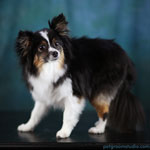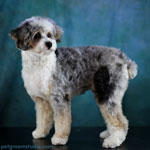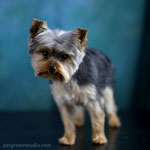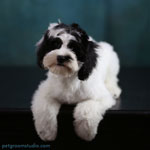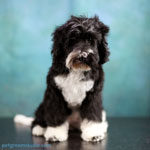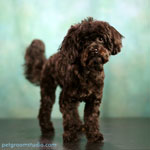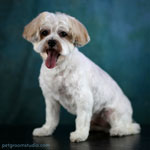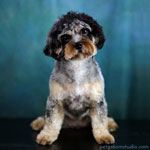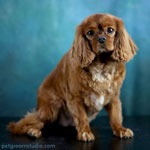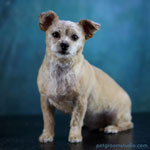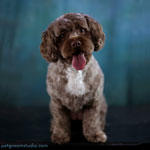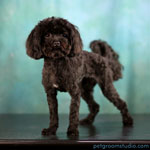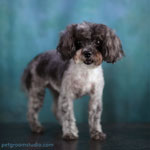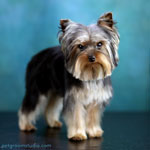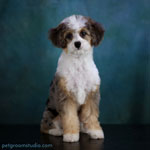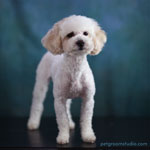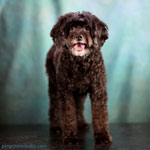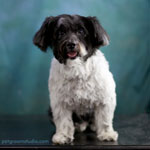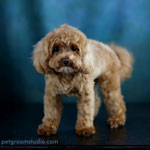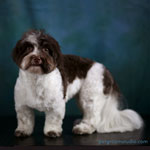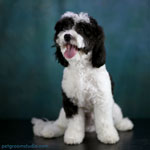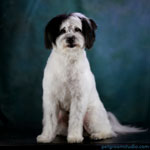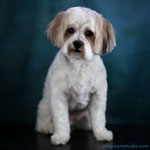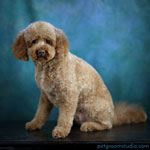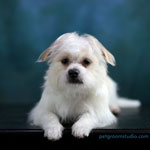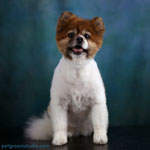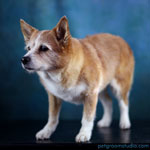Safety
Visit our procedures page for pet drop-off and pick-up information.
At Pet Groom Studio, we strive to give your pet as pleasant a grooming experience as possible. Part of that is being aware of the risks inherent in our work and making every effort to minimize them.
Observation: Pets are monitored throughout the grooming process for signs of distress and cared for accordingly. If your pet has an existing medical condition (ie. allergies, arthritis, luxating patella, heart conditions, blind/deafness, etc), please let us know. And we'll let you know as well if we notice anything we think you should have checked by your veterinarian.
Drying: For your pet's comfort, we use warm-air drying equipment. When dryer equipment is well-maintained, used properly, and in a climate-controlled environment, the drying process does not cause pets to overheat. This applies to both table-drying and cage-drying. While we do prefer to table-dry pets whenever possible, some animals find the volume of air and noise too stressful. In that case, we use a thermostat-controlled dryer hung on a well-ventilated cage to speed up coat drying in a more relaxed manner.
Restraints: We use slip leashes and grooming loops for walking and restraining pets. Pets who pull or fight the leash may experience redness on the skin or coughing. The best way to prevent this is proper training. We do our best to discourage pets from pulling while maintaining safe and proper control. If your pet has a collapsed trachea or other issues in their throat area, please let us know. We will use an alternate form of restraint.
Heights: Grooming tables and tubs are raised up to make them ergonomic for groomers. This means that your pet will likely spend time on surfaces three to five feet off the ground. While most pets quickly get comfortable in their grooming routine, some may try to jump onto or off of tables and tubs on their own. We use physical restraint to prevent this (ie. a grooming loop and/or belly strap). Well-behaved animals may not need any restraints at all. No pets are left unsupervised while they are up on the table or in the tub.
Allergic reactions: Our standard bathing and conditioning products are hypoallergenic, so allergic reactions are rare, but they can happen (in pets OR their people). While a light amount of itching is common in short-clipped areas, pets should not be allowed to scratch. They can quickly turn a small itch into an irritated infection. Please let us know right away if your pet has issues after grooming. We will make a note to switch products and procedures to reduce the likelihood of a reaction in the future and offer advice on soothing itchy spots. If your pet is excessively itchy after grooming, you may need to contact your veterinarian for advice on making them comfortable.
Clipper irritation: It's sometimes called "clipper burn", but that's a misnomer. It's not caused by using too-hot blades. (While blades do heat up during clipping, they are checked frequently and switched out as needed.) Clipper irritation is a result of a histamine reaction in the skin in response to microscopic damage caused by clipping hair very short. It's the same irritation humans are subject to when they shave with a razor. Like humans, some pets are more sensitive than others to clipper irritation. Also, various parts of the body are more sensitive than others (ie. around the eyes, pads of feet, and personal areas). For sanitary reasons, we typically take those areas very short. Let us know if your pet is especially sensitive and we will leave the hair slightly longer. We also have a variety of spritzes that can help reduce irritation.
Nicks and cuts: While we are obsessively careful about every clip and snip, there is a small risk that your pet may be scratched or cut during their grooming appointment. The danger is highest for uncooperative pets who are moving around during clipping. Pets with fragile skin (seniors, especially) are also higher-risk. Mats increase the likelihood of nicks and scratches as well. The tighter the matting, the greater the risk. Stretchy areas like armpits are also high-risk. In addition to clipper blades and scissors, metal brushes and combs may also cause skin damage, particularly during dematting. It is not uncommon for a nail to bleed during or after clipping as well. In most cases, minor nicks and scrapes heal quickly without need for veterinary attention. In all cases, we will apply basic first aid and discuss non-emergency injuries with you at pick-up.
Eye irritation: Pets' eyes are vulnerable during several parts of the grooming process. In the bath, shampoo can injure the eyes. To ensure this doesn't happen, we use tearless shampoo for faces and flush generously with water at the end of the bath. We are extremely cautious when using brushes, combs, and scissors near pets eyes. If pets are too uncooperative, we may opt not to work in that area at all and refer you to a veterinarian for further grooming. During the grooming process, pets occasionally get hairs in their eyes. Normally, these hairs won't cause any problems, and will flush out when the eye waters and blinks. However, if your pet is pawing at their eyes, they may have a hair stuck there. Flushing the eye with sterile saline can help remove it. In extremely rare cases, a hair can scratch or irritate the eyeball and require veterinary attention.
Ear infections: There is a great deal of debate in the pet professional community over how to prevent ear infections. We take ears on a case-by-case basis, in consultation with pet owners and their veterinarians. For many pets, allergies play a significant role, which means that changing their diet can prevent or reduce ear infections. For some pets, plucking ear hair can help keep the ear canal clean and dry, which helps prevent infections. In that case, we'll refer you to your veterinarian for that service. For other pets, plucking ear hair damages the skin to the point that it increases the risk and severity of ear infections. For pets with healthy ears, we use an antiseptic ear cleaner to help keep them that way. Ear cleaner kills bacteria, fungus, and removes moisture from the ear canal. For pets with dirty or mildly infected ears, we flush the ears with a mild shampoo solution before applying antiseptic ear cleaner. For pets with severely infected ears, we may opt to leave them alone completely and refer you to your veterinarian for treatment. To promote healthy air flow, we trim as much hair around and slightly inside the ear canal as your pet allows.
Unrestrained pets: We make every effort to keep pets secure in our facility. Dogs from different families are seldom in the studio at the same time, but when they are, they are always kept separate. Clients should always keep their pets on a leash or in a carrier when transporting them between the grooming studio and their cars. If you use a flexi-leash, please make it short and lock it. Do not allow your pets to get tangled up with objects, clients, or other dogs.
Stress and strain: Our goal is to give your pet a calm and comfortable grooming experience. Unfortunately, it can be a physically demanding process, especially if they are elderly, uncooperative, or have skin/coat issues. Older pets may be stiff and sore after standing for long periods of time. Overweight pets overheat quickly and may have soreness in their back or hips. Anxious pets may bark themselves hoarse or have diarrhea. Please talk to us about your particular pet's special challenges. There are often things you can practice at home to help ease the grooming process for your pet.
Contagions: Any time you take your pet outside of your house, you expose them to a variety of viruses, bacteria, and parasites. Your pet's best defense against disease is always proper vaccination, regular grooming, and a healthy immune system. We use veterinary-strength disinfectants to reduce the level of infectious organisms in the surfaces of our tub, floor, cages, table, and equipment. We will refuse service to pets suspected of having air-borne disease until they are cleared by a veterinarian. We ask that all clients inspect their pets for parasites and treat infestations according to their veterinarian's instructions before bringing them in for grooming.
Other concerns: Please feel free to ask us about any pet safety issues you may have.

